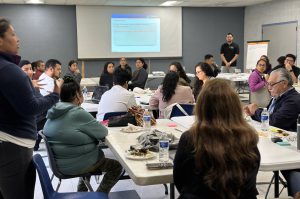
Advancing a Collaborative Agenda in Southeast LA
Advancing a Collaborative Agenda in Southeast LA In 2022, the California Community Foundation (CCF) launched the Regional Recovery Hub to strengthen place-based coordination in Los Angeles County
Variable Definitions:
Total Immigrant Population: The total amount of residents who was not born in the United States or Puerto Rico
Immigrant Population (%): The percentage of the total resident population who was not born in the United States or Puerto Rico
Immigrant Citizen Population: The percentage of people who were not born in the United States or Puerto Rico who are now naturalized U.S. citizens
Immigrant Non-Citizen Population: The percentage of people who were not born in the United States or Puerto Rico who are not currently naturalized U.S. citizens
Source:
American Community Survey (ACS), 5-year estimates, Table B05001
Years Available*:
2010 – 2023
*Note: Each year of available data shown above is a 5-year estimate, or an average of data collected over a five year period. 5-year estimates are used to increase the reliability of the data at small geographies like neighborhoods and census tracts. The years shown on the NDSC map represent the final year of the five year average (e.g. “2010” represents 2006-2010 data, “2011” represents 2007-2011 data, and so on). For the most impactful comparison of data over time, the ACS recommends comparing non-overlapping years (e.g. 2010-14 with 2015-19).
Total Immigrant Population
The total immigrant population includes both the citizen and the non-citizen immigrant population. This variable serves as the denominator for measuring and identifying trends in the immigrant citizen and non-citizen population. Thus, this variable is important for assessing the social and economic impacts of the total immigrant population.
Immigrant Citizen Population
Immigrants who are United States citizens are people who were born in another country and have become naturalized citizens in the United States, a process that often takes several years to complete. U.S. Citizenship offers many privileges including the ability to vote in elections, run for office, receive federal benefits and scholarships, travel overseas for extended periods of time, and sponsor other family members for green card status.
Measuring the number of immigrants who are citizens is important for understanding processes like immigration reform and voter registration. Additionally, understanding how many immigrants are or are not citizens is important for evaluating the differences in rights and privileges for immigrants, especially given the long and complex process necessary to achieve citizenship.
Immigrant Non-Citizen Population
Immigrants who are not United States citizens includes permanent residents with authorization documents, temporary migrants such as foreign students, humanitarian migrants such as refugees, and migrants without authorization documents. Should an individual complete the naturalization process to become a citizen, they would no longer be counted under this classification.
As opposed to the previous category, this group does not have access to the rights of citizens. As such, this metric is important for understanding how many immigrants are living in the US without the full rights of citizens.

Advancing a Collaborative Agenda in Southeast LA In 2022, the California Community Foundation (CCF) launched the Regional Recovery Hub to strengthen place-based coordination in Los Angeles County

Every ten years, the federal government conducts a “census,” where it counts every person living in the United States. The constitution mandates that all people

Our nation’s population is aging and will continue to grow older over the next several decades. There are currently 49.2 million people ages 65 and
